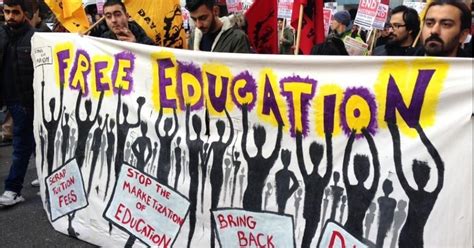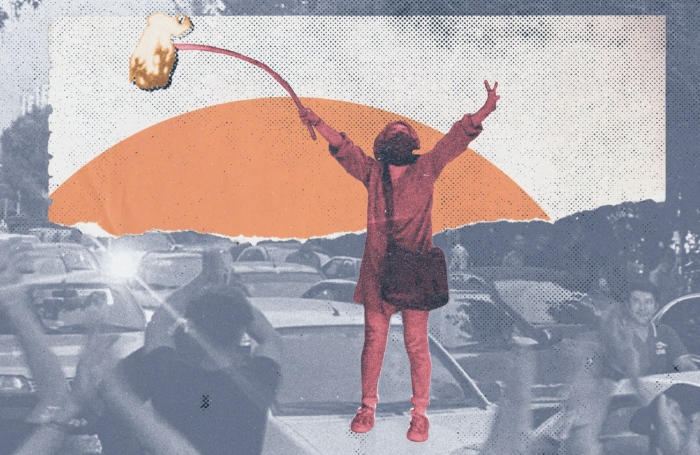Via Roar Magazine
The pandemic has exposed the disgraceful failures of market reforms in the British higher education sector. But the resistance of students continues.
- Author –Hector Rios-Jara
Ten years ago, tens of thousands of students flooded the streets of London protesting against fees, cuts and demanding free public education in the biggest student demonstration in British history. They took over the Conservative Party headquarters, hanging red and black flags from the rooftop and surrounding the building with barricades. The demonstration marked the rebirth of the British student movement and the beginning of a new generation of activists that would confront marketization and austerity over the coming decade.
Though students could not stop the further commodification of higher education, they succeeded in generating a culture of anti-market resistance, popularized the demand for public free education and contributed to the rise of democratic socialism in the UK. Ten years later, as thousands of students are coordinating the biggest rent strike in decades, it is important to reflect on the 2010 student movement and the lessons to be learned from it.
The rise and fall of the 2010 student revolt
In 2009, the outgoing Prime Minister Gordon Brown formed a commission to investigate the impact that the introduction of fees and loans in 1997 and 2006 had on university finance and the financial future of higher education. The resulting Browne Review proposed uncapping and increasing tuition fees to boost university incomes and stimulate the sector’s expansion. As the Review put it: “Higher Education Institutions must persuade students that they should ‘pay more’ in order to ‘get more’. The money will follow the students.”
Despite promises not to raise tuition fees, the newly-elected Conservative-Liberal Democrat coalition government used the review’s proposals as justification for its radical austerity agenda that would cut 70 percent of university teaching grants and triple tuition fees from £3,000 to a maximum of £9,000. This market-driven restructuring of university funding is what triggered the historic student revolt of 2010.
The movement took off in November as part of a national demonstration called by the National Union of Students and the University and College Union, with the support of the Education Activist Network and the National Campaign Against Fees and Cuts. The latter two were key to coordinating and encouraging the local anti-cuts student groups, which had been resisting university cuts and austerity since late 2009.
Many further education students and pupils also joined the demonstration in opposition to a rise in tuition fees and the elimination of the Education Maintenance Allowance (EMA), a weekly payment of £30 for students from poor backgrounds attending tertiary education. Many first-time protesters, often from ethnic minority and precarious working-class sectors, came from London’s suburbs and estates. For them, EMA provided essential income to support their studies and their families. Its elimination would be a serious economic loss. The participation of these newly-politicized students and pupils helped energize the movement and spread the protests beyond the university walls.
Between November 2010 and January 2011 hundreds of assemblies, networks and anti-cuts groups were involved in eight days of national action, weekly local rallies and demonstrations. Around 50 universities were occupied by students, who kept the national debate on the value of free education alive. The University College of London occupation and those in Glasgow and Sussex were the largest in the country and real symbols of the revolt.
Cornered by students, the government responded to the revolt with violence, legal actions and sanctions. On December 9, parliament approved the rise of tuition fees with a narrow majority of six MPs, while outside parliament the police kettled students the entire day. The student uprising did not stop the increase of tuition fees in England. But, protests succeeded in obstructing the government’s plans to dissolve the public funding system for universities once and for all.
Resistances and alternatives after 2010
Despite the bitter results of the 2010 protests, the student revolt gave rise to a new culture of resistance. In 2010, grassroots student movements favored horizontal forms of organizing, combining online and offline activism, popularizing the practice of occupations and decentralized networks for action. Most of these tools became the emblematic expressions of the first wave of anti-austerity protests and the Occupy movement of 2011.
These new forms of radical student activism survived 2010 and shaped the political culture at universities for years to come. In one way or another, anti-cuts groups, anti-casualization, divestment and free education campaigns, rent strikes and demands to decolonize the curriculum have appeared and reappeared right up to the present day. All of them resisting different expressions of university marketization.
The most notable examples of this tradition are the campaign for free education and the rent strike movement. The free education campaign was led by the National Campaign Against Fees and Cuts and remained active until 2017. Every year, free education demonstrations mobilized local groups engaged in anti-austerity actions.
Since 2015, students have also used a new tactic in student activism: the rent strike. These are used to fight against the rising costs of university accommodation, but they also advance the culture of horizontal and decentralized networks of coordination and direct action that emerged in 2010. In 2016, students won a two-year rent freeze at University College of London. During the pandemic, rent strikes became a popular tactic of the student movement, with thousands of students taking part in strikes at a dozen universities across the country. Recently, students from Manchester won a 30 percent rent cut after coordinating a rent strike and occupying a university building for a couple of weeks. Since then, the campaign has continued to spread to different campuses across the UK.
The culture of market resistance also played a significant role during the 2018 and 2019 pension strikes led by the University and College Union. The strike shocked the sector. It was the unexpected outcome of years of dispute between Vice-Chancellors and staff over the contribution of universities to staff pensions. However, it was the young generation of unionists, most of whom had previous experience in anti-marketization struggles, who boosted mobilization and won the ballot for industrial action. During the strike, student activists organized university occupations and joined the picket line during the first 14 days of the strike. The alliance between the unions and local student groups was an notable legacy of a decade of shared struggles and solidarity between university students and workers.
Free education and the rise of democratic socialism
The student revolt also played a role in the increasing popularity of democratic socialism in the UK. In 2010, Jeremy Corbyn and John McDonnell visited the UCL occupation, where around one hundred students were coordinating and keeping the revolt alive. Corbyn and McDonnell were the only MPs that supported the student protests and the only politicians welcomed at the heart of the revolt. The visit forged trust between student activists and the old guard of socialist Labour MPs. This new alliance laid the base for the massive support that Corbyn received from younger activists during the Labour leadership election in 2015 and a breeding ground for a new political culture of democratic socialism in the UK.
The rise of Corbyn and the increasing popularity of democratic socialism is probably a direct result of the 2010 protests and the impact they had on politics and policy. In the Labour manifestos for the general election of 2017 and 2019, Corbyn included free education as a key policy, marking a historical break with New Labour’s higher education policies, which between 1997 and 2015 remained in favor of moderated fees and more robust systems of loans and scholarships.
In contrast, Corbyn’s proposal of free university education included the re-establishment of public grants and the elimination of tuition fees for new undergraduates. The proposal represented a late victory for student activists and marked a rebirth of the free education debate.
Students against 2017 market reform
The intertwining of this new culture of student activism and Corbynism created tensions regarding the autonomy of the movement and the link between student and party politics. But during 2016 and 2017, both political forces collaborated in confronting a new wave of market reforms. In 2016, the Conservative government introduced a new set of higher education reforms that aimed to deregulate the sector and facilitate the expansion of new, for-profit, universities. The reforms reintroduced some policies that had been postponed in 2010 under the pressure of protests, such as the elimination of the public funding body of universities, its replacement for a new regulator and a new system to measure teaching quality.
Although the convergence of local campaigns and Labour parliamentary pressure helped to soften some of the planned deregulations, without mass mobilizations like those of 2010, efforts to stop this second set of reforms were less successful. As a result, parliament passed the new Higher Education and Research Act in 2017, finalizing the marketization process that had started in 2010. With this reform, the British higher education system became a semi-open market, highly dependent on student fees and debt, with little support from government funding and minimal regulation on the quality of the education that universities offered.
Unlike in 2010, this second market victory was not followed by a sense of consensus between political parties and public opinion. Parliamentary inquiries on student fees and student debt show that the 2010 and 2017 reforms negatively affected the quality of education at some universities. Tuition fees were too high, and they did not improve the experience of students. Students have higher debts — around £40,000 — because of fees and maintenance loans. They are struggling to find jobs, and many of them are not earning enough to pay back their debts.
The rise in fees and living costs disproportionally affected students of working-class backgrounds and ethnic minority groups, who were not attending universities in the numbers the reforms had promised, making up for just 30 and 24 percent of university enrollments, respectively. The original assurance of “paying more for getting more” was only valid for some universities and for students from more privileged backgrounds.
Specialized institutions devoted to humanities, arts and social sciences suffered in particular. The reforms scrapped public grants, their most stable sources of income, forcing them to forego their traditional premise of providing education for education’s sake, and to adopt a more profit-oriented approach to teaching and research in order to survive.
The negative impacts of market reforms, the political pressure from students and the Labour proposals together managed to successfully change the public debate and to popularize the demand for free education. In 2018, the government called for a new university commission, which recommended the reduction of tuition fees from £9,250 to £7,5000 and the re-introduction of teaching grants. This was the first time in decades that a government commission proposed to reduce fees and increase public spending in education.
The longstanding legacy of 2010
Over the past decade, British students lost two key battles against market reforms and in the same period democratic socialism was unable to claim any victories in the electoral arena. However, the student resistance shaped the national debate on education and foresaw the crisis in higher education that has quietly been gaining momentum since the 2010 and 2017 reforms.
Today, the pandemic has exposed the vulnerabilities of financialized higher education, most of which were already denounced by students ten years ago, such as the lack of democratic accountability of university managers; the primacy of economic expansion over educational quality and community care; the unsustainable financial basis upon which universities were growing and expanding; and, lastly, the unfair fees students were charged for their studies and the loans they were forced to take out to pay for these.
During the pandemic, the speculative bubbles of constant growth and permanent expansion of universities have imploded. The deep economic deficits that universities face and the uncertain future of the sector are direct consequences of market reforms. The pandemic has also uncovered the worst practices of university management and marketing. Against all scientific advice, British university managers insisted on reopening campuses and called for students to return to their studies. The purpose was clearly not to provide education; instead, managers saw the end of the lockdown and the beginning of the academic year as an opportunity to simply balance the books.
Now, a whole generation of undergraduate students are trapped in university halls, under the constant pressure of high tuition-fees, yearly rent contracts, larger debts and without the care and support that they need. This is the reason why today rent strikes, anti-casualization struggles, industrial actions, student occupations and all the expressions of anti-market culture of resistance developed around 2010 are spreading like wildfire across UK universities.
So, what is the legacy of 2010 and the impact of a decade of student organizing? The 2010 student revolt marked the starting point of a new culture of anti-market resistance and the formulation of radical alternatives to market policies. This culture remains alive and pertinent today. In occupations, protests, rent strikes and on picket lines university activists continue to oppose market reforms and to develop the vision of a new public university where democracy, equality and public commitment are priorities.
This culture of resistance and the desire of rebuilding a public and free higher education system are the longstanding and vivid legacies of the student revolt of 2010. The struggle continues for a publicly funded and democratically managed university system in the UK and beyond.




